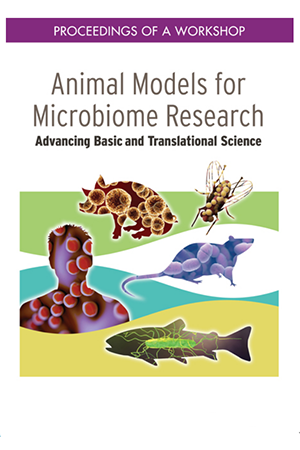- Improve the depth and breadth of analysis of microbial communities using various model organisms
- Address the challenges of standardization and biological variability inherent in gnotobiotic animals-based research
- Examine the predictability and translatability of preclinical studies to humans
- Discuss strategies for expanding the infrastructure and tools for conducting studies in these types of models
 Animal Models for Microbiome Research: Advancing Basic and Translational Science: Proceedings of a Workshop1 is edited by Joe Alper, Lida Anestidou, and Jenna Ogilvie. Each of its chapters addresses a different aspect of microbiome research, with a focus on animal models.
Animal Models for Microbiome Research: Advancing Basic and Translational Science: Proceedings of a Workshop1 is edited by Joe Alper, Lida Anestidou, and Jenna Ogilvie. Each of its chapters addresses a different aspect of microbiome research, with a focus on animal models.
Non-Murine Microbiome Animal Models
Much microbiome research has focused on the mouse as a model organism, and the mouse is the primary choice for preclinical proof of concept studies. Recently, researchers have started using other animal models, including zebrafish, piglets, and Drosophila, as they realize the mouse is not a perfect model for microbiome research.Chapter 2 discusses A Trans-Kingdom Perspective on Animal Models and Microbiome Research. In this context, "Trans-Kingdom" refers to the host's interaction with the complete microbiome, including viruses, bacteria, Archaea, fungi, and protists, as well as the interactions between microbiota.
Chapter Three explores Non-Rodent Models for Microbiome Research, such as eukaryotic models, (e.g. C. elegans), Drosophila melanogaster, zebra fish, and piglets.
Advantages of Non-Murine Models
One advantage of using C. elegans is the ability to conduct high-throughput studies with gnotobiotic organisms. Drosophila is easy to manipulate experimentally and to maintain as germ-free. The natural Drosophila microbiome is an order of magnitude less diverse than mammals, with Acetobacteraceae, Lactobacillales, and Protobacteria being the dominant strains. Additionally, there is a wealth of genomic and genetic information available for Drosophila.The section finishes with an overview of piglets in microbiome research. Piglets provide the opportunity to characterize postnatal assembly of the microbiome during suckling and weaning transition.
In Vitro Systems and Microbiome Research
The next chapter covers in vitro systems, such as bioreactors, organoids, and human organs on microfluidic chips.Bioreactors
Researchers have developed miniature bioreactor arrays to study how microbial communities resist invasion by pathogens, such as one used to develop defined microbial communities for treatment of Clostridium difficile infection2. Other uses for bioreactor arrays include studying microbiota-driven drug metabolism, microbiota production of beneficial and detrimental metabolites, and learning how defined microbial consortia form from purified strains of bacteria.Microfluidic Chips
Developing human organs on chips is another exciting area of research. These have organ-level functions and can be used to accelerate drug development or replace animal testing. Researchers at the Wyss Institute have created a "peristaltic human gut-on-a-chip that re-creates the human intestine." This gut-on-a-chip can be used to culture bacteria and observe how they affect the gut epithelium.Modelling Human Microbiota in Animal Systems
Moving on from the types of models, the next chapter outlines how to model human microbiota in animal systems. The methodologies for associating animal models with human microbiota are well understood, but designing studies and interpreting results to identify mechanistic links between microbes and human disease is still unfolding.Some studies have shown the ability to transfer disease phenotypes from humans to germ-free mice through microbiota transfers3,4,5. To judge whether a microbe is the cause of a given disease researchers are often trying to satisfy the four criteria in Koch's postulate:
- The bacteria must be present in every case of the disease
- The bacteria must be isolated from the host with the disease and grown in pure culture
- The specific disease must be reproduced when a pure culture of the bacteria is inoculated into a healthy susceptible host
- The bacteria must be recoverable from the experimentally infected host
Reproducibility of Microbiome Studies
Chapter Five, Experimental Reproducibility using Gnotobiotic Animal Models, explores the challenges microbiome researchers face with reproducibility when utilizing gnotobiotic mice. "One of the most difficult aspects of animal husbandry is controlling or standardizing the animal microbiome, in part because it is still not well understood," said Andrew MacPherson from the University Hospital of Bern, speaking at the workshop.Researchers sometimes observe phenotypic differences when examining mice from a single inbred strain. This table included in the book provides some understanding into this phenomenon.
| Bottom-Up Models | Convergence | Top-Down Studies | |
| Definition | Studying axenic models or those with very simple microbiotas, e.g., germ-free or monocolonizations | Studying defined components of complex microbiotas (e.g., IgA-bound bacteria) in a gnotobiotic system | Studies of complex and natural microbiotas (e.g., human samples, SPF) |
| Disadvantages |
|
| |
| Advantages | Molecular mechanisms and interactions between microbes or their metabolites and the immune system can be defined | Defined and reproducible system with a microbiota that aims to be representative of a natural situation and is amenable to experimentation | Representation of a natural situation that models or directly shows the human condition |
Table 1: Different Types of Experimental Models for Understanding Microbiome-Associated Phenotypic Variability
The chapter further explores the role of host genetics, immunological variation, biological sex, and diet in this variability.
Establishing Gnotobiotic Facilities
The workshop's final session addressed the establishment of gnotobiotic facilities. Speakers discussed the advantages for institutions in establishing their own gnotobiotic facilities. These are expensive, challenging facilities to design, build and maintain, yet the rewards are well worth it. Gnotobiotic facilities help in recruiting faculty and securing grant funding from governments and foundations.Conclusions
In Reflections on the Workshop, Vincent Young from the University of Michigan shared highlights of the workshop. Young discussed some of the issues raised by the speakers:- Scale, both in terms of cost but also with regard to which interactions are important to study in a given set of experiments. "How much are you going to focus on various aspects of the host, how much on the various aspects of the indigenous microbiota, and how much on pathogens?," asked Young.
- Complexity is another element both in terms of technical issues and with respect to what can be controlled in any set of experiments.
- Translatability to human conditions is yet another consideration, as are relevance and variation. "How much variation should one allow in an experiment, given that variability is part of what defines being human?"
The book is available at the National Academies Press or at Amazon.















.jpg)

.jpg)
.jpg)
.jpg)
.jpg)





.jpg)


.jpg)
.jpg)

.jpg)


.jpg)





.jpg)

.jpg)





